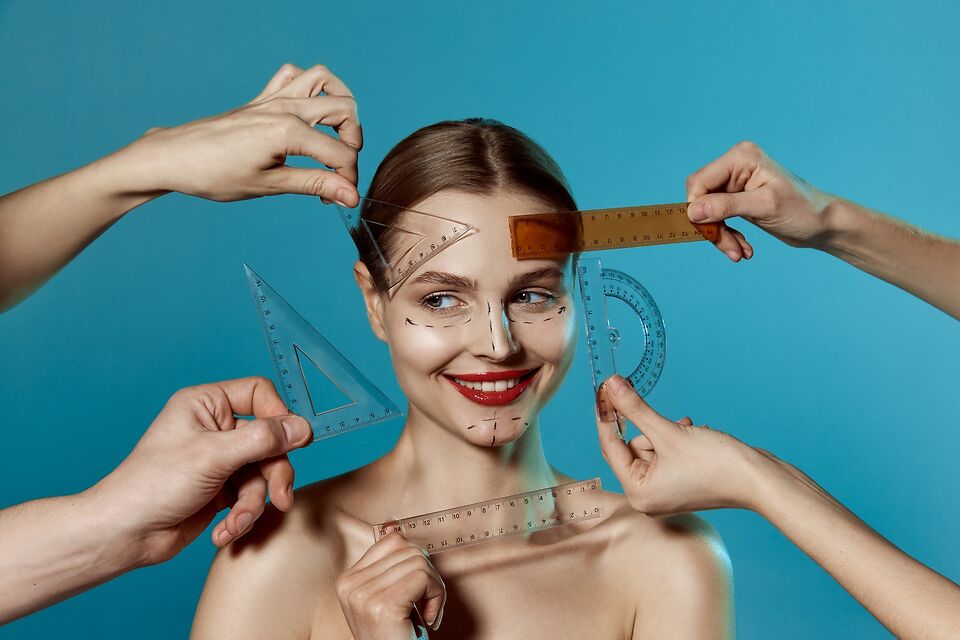In the realm of beauty, the concept of symmetry holds undeniable allure. From ancient art to modern-day aesthetics, symmetrical faces have long been associated with attractiveness and perceived beauty. Haute Beauty Ambassador, Dr. Sachin Shridharani of LUXURGERY, emphasizes the pivotal role of symmetry in achieving balanced facial aesthetics, but just how significant is it?
 Photo Credit: Courtesy of Anton Vierietin/Shutterstock
Photo Credit: Courtesy of Anton Vierietin/Shutterstock
Symmetry: The Foundation of Facial Harmony
Symmetry is not merely a cosmetic preference; it serves as the cornerstone of facial balance and harmony. In the domain of facial aesthetics, balance denotes the equilibrium and proportion of facial features. When facial features exhibit asymmetry, it can subtly disrupt the perception of beauty and attractiveness.
Considered an essential component of facial aesthetics, symmetry influences how we perceive an individual's attractiveness and youthfulness. Whether it's the alignment of the eyes, the symmetry of the nose, or the balance of the lips, subtle deviations from symmetry can alter our perception of facial harmony.
Technological Advancements: Revolutionizing Facial Understanding
The advent of technological innovations, particularly facial recognition software, has revolutionized our understanding of facial balancing. These cutting-edge tools enable practitioners to objectively analyze facial proportions, symmetry, and other aesthetic factors with unprecedented precision.
By harnessing the power of facial recognition software, practitioners can quantitatively assess facial asymmetries and deviations from ideal proportions. This objective analysis provides invaluable insights for cosmetic procedures and facial balancing techniques, enhancing both the precision and efficacy of aesthetic interventions.
View this post on Instagram
Common Techniques in Cosmetic Procedures
Facial balancing encompasses a spectrum of interventions, ranging from non-invasive skincare treatments to surgical corrections. Among the most commonly employed techniques are Botox/neuromodulators and dermal fillers, which offer minimally invasive solutions to achieve facial balance.
While non-invasive and minimally invasive procedures are preferred for their minimal downtime and reduced risk, surgical interventions such as rhinoplasty, chin liposuction, and buccal fat pad removal remain essential options for addressing more pronounced asymmetries and structural imbalances.
Gender-Specific Considerations
Gender plays a pivotal role in defining the ideal facial proportions. Traditionally, a more angular and defined jawline is favored in males, whereas a softer, more rounded jawline is preferred in females. Additionally, the ideal ratio of facial features such as the eyes, nose, and lips may vary between genders, reflecting societal standards of beauty and masculinity/femininity.
Influences of Age and Ethnicity
Age and ethnicity exert significant influence on the ideal proportions of the face. With advancing age, changes in facial volume, skin laxity, and bone structure can alter facial balance, necessitating tailored approaches to rejuvenation and enhancement.
Similarly, diverse ethnicities may exhibit distinct facial features and proportions that are deemed attractive within their cultural context. Consequently, considerations of age and ethnicity are paramount when devising personalized strategies for facial balancing and cosmetic enhancement.
In the pursuit of facial harmony and balance, symmetry emerges as a guiding principle, shaping our understanding of beauty and aesthetics. Through technological advancements and a nuanced appreciation of gender, age, and ethnicity, practitioners are equipped to unlock the inherent beauty of every face, restoring balance and confidence with precision and artistry.
For more information, visit Sachin Shridharani, MD, FACS's social media:





















